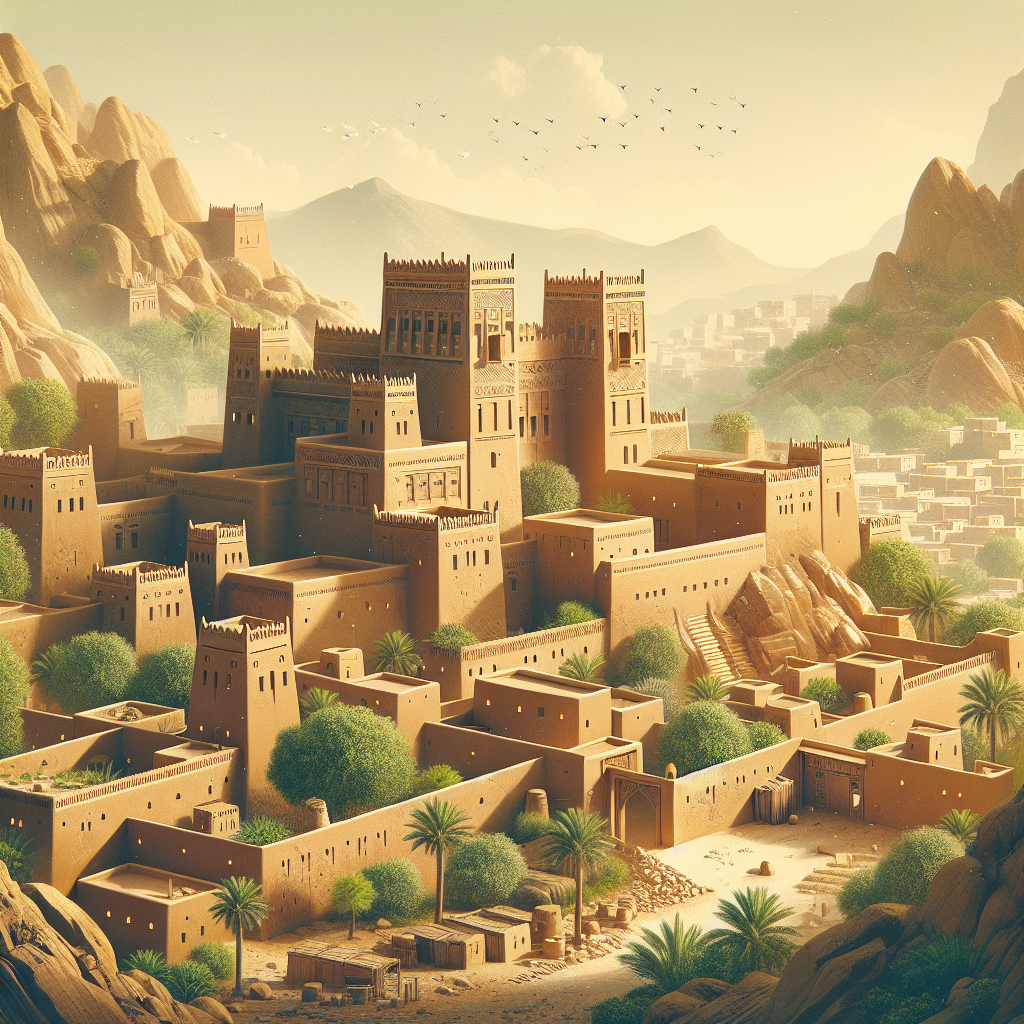Diriyah’s Rich History: Discover the Birthplace of Saudi Arabia

Imagine walking through a city that lies at the heart of Saudi Arabia’s rich history and vibrant culture—welcome to Diriyah, a site of immense historical significance and modern revival. In this article, we explore the unique cultural heartbeat of Diriyah, celebrated as the birthplace of the First Saudi State. Discover how its traditional mud-brick architecture stands as a testament to timeless craftsmanship, and learn about the ambitious Diriyah Gate project that aims to preserve its legacy while spearheading cultural tourism. Dive in to uncover the profound impact of Diriyah on Saudi Arabia’s past, present, and future.
Historical Significance of Diriyah
The Rise and Development of Diriyah as a Political and Cultural Hub
Diriyah holds a prestigious place in the annals of Saudi Arabian history, primarily recognized as a pioneering political and cultural center. From its inception, Diriyah emerged as a crucial node for governance and trade, leveraging its strategic location near the Wadi Hanifa. This positioning enabled the city to flourish as a crossroads for merchants and scholars, fostering an environment of cultural exchange and growth. The development of Diriyah was instrumental in shaping its identity as a vital hub for administration and diplomacy, attracting influential figures and facilitating significant political discourse.
Diriyah as the Birthplace of the First Saudi State and its Role in Saudi Arabian History
The historical gravitas of Diriyah is further cemented by its distinction as the birthplace of the First Saudi State. Under the visionary leadership of Imam Muhammad ibn Saud, the city became the nucleus for the consolidation and expansion of what would eventually evolve into the modern Kingdom of Saudi Arabia. Diriyah’s role in the unification efforts against external powers demonstrated its resilience and commitment to sovereignty. The city’s fortifications and strategic alliances formed the foundation of the nascent state, underscoring Diriyah’s vital role in the historical narrative of Saudi Arabia’s emergence as a nation.
The Cultural Essence: The City of Earth
Explanation of Why Diriyah is Called the “City of Earth”
Diriyah is fondly referred to as the “City of Earth” due to its rich historical significance and unique architectural landscape, which embodies the deep connection between the land and its people. This name reflects the ancient mud-brick structures that dominate the area, showcasing the traditional Najdi architectural style rooted in the region’s history.
The Architectural Style and the Unique Mud-Brick Construction of Diriyah Buildings
The architectural style of Diriyah is characterized by the use of adobe, a sustainable building material consisting of earth and straw, developed over centuries to adapt to the harsh desert climate. These mud-brick buildings not only maintain a cool interior temperature but also represent a harmonious blend with the surrounding environment, preserving both aesthetic and cultural values. Noteworthy features include intricate detailing on doors and windows, and fortifications that once protected its inhabitants.
Formation of the First Saudi State
Timeline and Events Leading to the Emirate of Diriyah
The story of Diriyah is intricately tied to the emergence of the First Saudi State. It began in the 18th century when Diriyah became the epicenter of political and religious reform. In 1744, a pivotal year in Saudi history, the alliance between Muhammad ibn Saud and Islamic scholar Muhammad ibn Abd al-Wahhab was formed. This partnership ignited a movement based on purifying Islam and contributed significantly to the formation of the state.
As Diriyah gained prominence, it evolved into a hub of political power and religious reform. This era marked the beginning of a unification effort across the Arabian Peninsula, with Diriyah at its heart, leading to the annexation of neighboring regions.
Key Figures and Battles
Several key figures played crucial roles in the establishment of the Emirate of Diriyah. Muhammad ibn Saud, the emir who founded the first state, and Muhammad ibn Abd al-Wahhab, the religious leader, were instrumental in shaping the foundations of modern-day Saudi Arabia. Their collaboration fostered a unified governance model that integrated religious reforms with political ambitions.
Numerous battles were fought to solidify Diriyah’s authority across the region. Notable among them was the Battle of Riyadh in 1773, which exemplified the tactical prowess and strategic visions of its rulers. These confrontations often ended in expanding the emirate’s influence, establishing Diriyah as a formidable force in the Arabian Peninsula.
Through these events and figures, Diriyah’s significance as the birthplace of the First Saudi State is immortalized, marking its role as a guardian of cultural and religious legacies.
The Birthplace of Saudi Arabia: What Does Diriyah Mean in Arabic?
Understanding the Etymology of Diriyah
The name “Diriyah” holds deep-rooted significance in the annals of Saudi Arabia’s history. In Arabic, Diriyah is derived from the word “dariyah,” which refers to a settlement or abode. This nomenclature underscores its historical role as a settlement that would rise to become the cradle of the nation. The choice of this name is emblematic of its stature as a foundational pillar in the heritage and identity of Saudi Arabia.
Symbolic Significance in National Identity
Diriyah’s place in the historical and cultural tapestry of the kingdom extends beyond its name. It symbolizes the unyielding spirit and unity that shaped the nation’s identity. As the original seat of power and the birthplace of the first Saudi state in the 18th century, Diriyah stands as a beacon of the visionary leadership and cultural renaissance that propelled Saudi Arabia onto the world stage. Its unwavering presence in the historical narrative fortifies its position as a cornerstone of national pride and cultural identity.
Modern Renaissance: The Diriyah Gate Project
Overview and Purpose of the Diriyah Gate Project
The Diriyah Gate Project is an ambitious initiative aimed at preserving and revitalizing Diriyah, a site of immense historical importance. This project seeks to transform Diriyah into a global cultural and heritage tourism destination, showcasing its rich history and cultural assets. By restoring traditional Najdi architectural styles and enhancing the area’s infrastructure, the project promises to bring Diriyah’s legacy into the modern age while maintaining its authentic cultural essence.
Discussion on Cultural Tourism and Job Creation
The Diriyah Gate Project is not just a restoration effort; it’s a catalyst for cultural tourism and economic opportunity. The development plans include museums, cultural institutions, and interactive exhibitions that aim to attract tourists worldwide, drawing them into the heart of Saudi Arabia’s cultural and historical narrative. Additionally, the project is expected to create thousands of jobs, providing opportunities for local communities and stimulating economic growth in the region. Through these initiatives, Diriyah will not only honor its past but also forge a vibrant and sustainable future.
Geographical and Architectural Overview
Location and Geographical Significance
Diriyah is strategically located in the northwestern outskirts of Riyadh, the capital city of Saudi Arabia. Nestled along the fertile valleys of Wadi Hanifa, Diriyah served as a critical junction on ancient trade routes. Its proximity to Riyadh has further amplified its importance, making it a focal point for cultural and economic activities in the region.
Notable Structures and Historical Relevance
Diriyah boasts several impressive structures that reflect its rich history and architectural ingenuity. The Diriyah Palace, a prominent landmark, encapsulates the grandeur of the region’s past. Built using traditional Najdi architectural styles, these structures are characterized by their unique mud-brick construction, which provides natural insulation against the harsh desert climate. The well-preserved buildings stand as a testament to the ancient construction techniques and the city’s historical significance as a political and cultural beacon in the Arabian Peninsula.
Conclusion
Diriyah stands as a testament to Saudi Arabia’s rich historical tapestry and cultural vibrancy. From its pivotal role in establishing the First Saudi State to its unique mud-brick architecture that earned it the title “City of Earth,” Diriyah’s legacy is both profound and enduring. Today, through initiatives like the Diriyah Gate Project, it continues to thrive as a beacon of cultural preservation and economic regeneration, ensuring that its stories and structures remain vital for future generations. Ultimately, Diriyah not only symbolizes the roots of Saudi Arabia but also represents an evolving narrative of innovation and tradition, marking its significance as a cultural and historical landmark in the region.
In conclusion, Diriyah stands as a monumental testament to Saudi Arabia’s rich history and culture, earning its title as the historical and cultural heart of the nation. From its origins as a political and cultural hub and the birthplace of the First Saudi State, to its unique mud-brick architecture symbolizing the “City of Earth,” Diriyah’s legacy is deeply woven into the fabric of Saudi national identity. The etymological roots of “Diriyah” further enrich its symbolic importance, while modern initiatives like the Diriyah Gate Project signal a renaissance aimed at preserving this heritage for future generations. This fusion of historical reverence and modern development highlights Diriyah’s enduring role as a cornerstone of Saudi history and a beacon for cultural tourism and economic growth.
We invite you to share your experiences or comments about Diriyah below. For those eager to explore more about Saudi Arabia’s cultural landmarks, we encourage you to read related articles linked here. Stay informed and inspired by subscribing to our newsletter, bringing the fascinating stories of Saudi Arabia’s heritage right to your inbox.

Very interesting info !Perfect just what I was searching for!